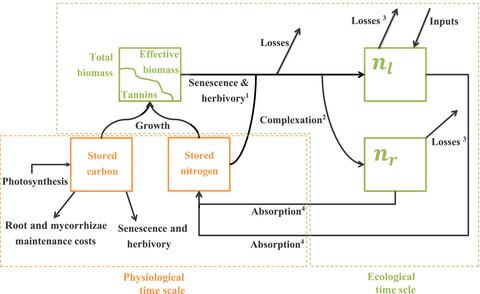Our official English website, www.x-mol.net, welcomes your
feedback! (Note: you will need to create a separate account there.)
Positive plant–soil feedback trigger tannin evolution by niche construction: A spatial stoichiometric model
Journal of Ecology ( IF 5.3 ) Pub Date : 2019-07-18 , DOI: 10.1111/1365-2745.13234 Jean‐François Arnoldi 1 , Sylvain Coq 2 , Sonia Kéfi 3 , Sébastien Ibanez 4
中文翻译:

植物-土壤的正反馈通过小生境构建触发单宁进化:一种空间化学计量模型
更新日期:2019-07-18
Journal of Ecology ( IF 5.3 ) Pub Date : 2019-07-18 , DOI: 10.1111/1365-2745.13234 Jean‐François Arnoldi 1 , Sylvain Coq 2 , Sonia Kéfi 3 , Sébastien Ibanez 4
Affiliation

|
- Among plant traits, plant secondary metabolites such as tannins mediate plant–herbivore interactions but also have after‐life effects on litter decomposition and nutrient cycling. We propose that niche construction mechanisms based on positive plant–soil feedback (PSF) could influence the evolution of tannin production.
- By modelling the flow of nitrogen (N) and carbon (C) through plants and soil in a spatially explicit context, we explored the relative contribution of herbivory and positive PSF as drivers of tannin evolution. We assumed soil N to be contained in labile and recalcitrant compartments, the latter made of tannin–protein complexes from which plants can absorb nutrients via associations with mycorrhizal fungi.
- In infertile environments and for plants with low biomass turnover rates, we show that when tannins modify soil properties locally, positive PSF alone can drive their evolution. We further predict the existence of positive coevolutionary feedback between associations with mycorrhizal fungi with a decaying ability and tannins, possibly triggered by the evolution of the latter as protection against herbivores. In line with our theoretical results, empirical evidence suggest that tannins are mostly present in plants with low tissue turnover, associated with mycorrhizal fungi able to decay organic matter and inhabiting infertile environments.
- Synthesis. Our model proposes that the evolution of tannin production can be triggered by positive plant–soil feedback, provided that tannins promote the local N retention and that mycorrhizal fungi associated with plants are able to absorb N from tannin–protein complexes. In our model, tannin production evolves only in infertile ecosystems, in agreement with field observations. Our findings highlight that the strength of niche construction depends on the ecological context, hence that global ecological properties constrain local eco‐evolutionary dynamics.
中文翻译:

植物-土壤的正反馈通过小生境构建触发单宁进化:一种空间化学计量模型
- 在植物性状中,植物次生代谢物(如单宁)介导植物与草食动物的相互作用,但对凋落物分解和养分循环产生来世影响。我们建议基于正植物-土壤反馈(PSF)的利基构建机制可能会影响单宁生产的演变。
- 通过在空间上明确的上下文中对植物和土壤中氮(N)和碳(C)的流动进行建模,我们探索了草食和正PSF作为单宁演变驱动因素的相对贡献。我们假定土壤N包含在不稳定和顽固的区室中,后者由单宁-蛋白质复合物组成,植物可以通过与菌根真菌的结合吸收养分。
- 在不育环境中以及对于具有低生物量转换率的植物,我们证明了单宁酸局部改变土壤特性时,仅正PSF就能驱动其进化。我们进一步预测与具有衰减能力的菌根真菌和单宁之间的协会之间存在正协同进化反馈,这可能是由于后者作为草食动物的保护而引起的。与我们的理论结果一致,经验证据表明,单宁大部分存在于组织转换率低的植物中,与能够腐烂有机质并居住在不育环境中的菌根真菌有关。
- 综合。我们的模型提出,只要单宁能够促进局部N保留,并且与植物相关的菌根真菌能够从单宁-蛋白质复合物中吸收N,就可以通过植物-土壤的积极反馈来触发单宁生产的演变。在我们的模型中,单宁生产仅在不育生态系统中进化,这与实地观察一致。我们的发现表明,生态位建设的强度取决于生态环境,因此,全球生态属性限制了局部生态进化动力学。











































 京公网安备 11010802027423号
京公网安备 11010802027423号